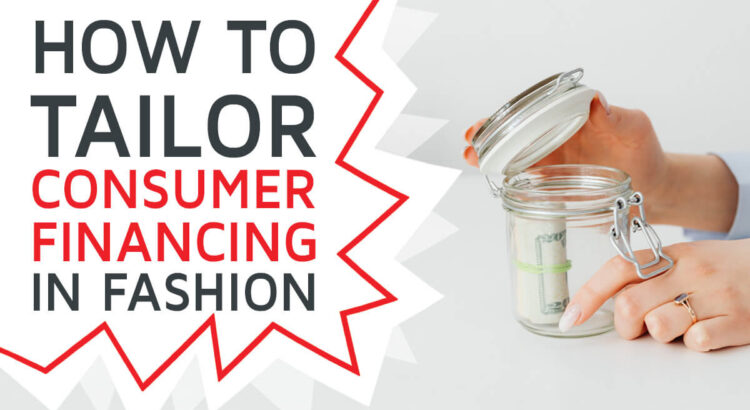As e-commerce continues to grow, online retailers are constantly looking for ways to increase their customer base and improve customer satisfaction. One way they are achieving this is by offering customer financing options. In this article, we will delve into:
- The various types of customer financing available in fashion
- The potential challenges that retailers might face when offering financing options
- The competitive edge gained through customer financing
- How to offer frictionless financing
So, let’s get to it.
The Many Options for Customer Financing
Consumer financing has been around for quite some time. But only through recent advancements it has become easier and less costly for retailers to offer it. This has opened new revenue opportunities for businesses and has become particularly prevalent during the isolation period of COVID-19 when online shopping rose in popularity.
With a troubled economy, rising cost-of-living and high inflation prevailing in many countries, consumers are looking for ways to soften the financial impact of their purchases. Not only low- to mid-income customers are affected, but also luxury shoppers.
30% of luxury shoppers in the US said they would consider slashing their designer spending, with around 20% anticipating a switch to less expensive products and brands.
Thus, customers across the board are seeking out brands that offer them generous financing options. Meeting their demands also has a positive impact for retailers. Offering consumer financing increases customer conversion, encourages repeat purchases, and positively impacts the average order value.
Here are a few options for deferred payments, a common type of customer financing:
1. Credit Cards
Strictly speaking, credit cards are not an instrument of consumer financing. However, they are a way to defer payment to a later billing period. And until today, other options of financing have to be measured against them: Credit cards have been the standard for customers seeking financial leeway for a long time, despite the strict regulations under which they operate. Today, however, younger customers are shunning credit cards. Instead, they explore other forms of financing like Buy Now, Pay Later (BNPL) options. They appear more trustworthy to this demographic and offer quicker onboarding.
2. Store Credit Cards
Store credit cards are credit cards that can only be used at specific stores – a halfway house between credit cards and other branded financing options. They are typically offered by larger retail outlets and luxury fashion brands, often in partnership with major card networks like Visa or Mastercard. These cards may offer benefits when customers shop at the brand’s stores or carry interest only under certain conditions.
3. Consumer Loans/Leases
This way of financing has been common for decades. Customers have to transfer monthly installments from their bank accounts until the full purchase amount is paid. Those installments typically carry a low interest rate. In the fashion industry, consumer loans are not as pervasive, as most customers use them for high-priced items. However, for luxury brands, they might be an option to consider. Not paying installments or paying late may have an impact on a customer’s creditworthiness and might lead to their inclusion in debt registers. However, many customers value consumer loans for their clarity in payment terms and the predictability of follow-up payments.
4. Purchase-on-Account
Before BNPL came along, purchase-on-account acted as the typical flavor of buying something now and paying the full amount at a set due date in the future. In this case, stores and brands run their own credit accounts for customers with specific terms and conditions. Customers might also make multiple purchases all counting towards the account. In some cases, the company might also ask buyers to make a down payment for a part of the purchase amount, and let them pay the rest later.
5. Buy Now, Pay Later (BNPL)
BNPL options are popular with younger generations, who consider them to be safer than credit cards. BNPL appeals to those without a strong credit history and offers benefits like easier onboarding, weaker credit constraints, clearer repayment terms, and lower dependency on financial institutions. Merchants can choose from a variety of providers (e.g. Klarna, Affirm) – some of them white label. Alternatively, they can even set up their own Buy Now, Pay Later solutions, too. This has a number of advantages such as no PSP usage fees and full control over the financing terms and conditions.
Problems and Challenges of Fashion Luxury Financing for Online Fashion Retailers
Intransparent Policies
Customers expect transparency. Therefore, hidden costs, deadlines, or limits in the small-printed text can ruin their payment experience. Especially for fashion companies working with third-party providers like credit card issuers, clear terms are crucial for customer satisfaction and loyalty.
Non-transparent financings, such as ambiguous consumer loan agreements or BNPL schemes that downplay late payment repercussions, could lead to overspending as the financial impact of purchases is delayed. Consumer protection in this area is currently inadequate, but financial institutions and regulators are working hard to bridge this gap.
Fee Management
It’s crucial for every business to understand the fee structures of its partners. Typically, merchants end up paying a percentage of the purchase price to the financial service provider. On the consumer’s end, fees or interest may be applied when opting for a financing option.
While designing in-house offers, businesses must consider their own fee structure. Should the customers be charged interest for using a financing option? Or, should the merchants pay a fee for offering the option to their customers? In most scenarios, keeping these charges low could provide a competitive edge over typical credit card or BNPL providers.
Interestingly, many BNPL providers charge dunning charges and late payment fees ranging from 2 to 8 percent which can sometimes be higher than regular credit card fees. When companies don’t communicate such charges in a transparent way, this can lead to customers overestimating their purchasing power. The catch? The actual costs are concealed. It’s only free when customers adhere to the rules.
Costs and Profitability
Offering consumer finance options can significantly boost your conversion rates. However, it’s crucial for businesses to consider the associated costs. Whether you’re managing the service internally or outsourcing, expenses are inevitable. These can range from fees for third-party providers and credit card schemes to the costs of maintaining your own infrastructure.
Moreover, implementing digital consumer financing solutions may also eat into your profits in unpredictable ways. As industry expert Benjamin Uhlmann notes, providing a “Buy Now Pay Later” (BNPL) option like Klarna could potentially lead to an increase in product returns. Although your conversion rate might climb, the costs associated with returns and logistics could offset these gains.
It’s worth noting that easy returns and refunds are increasingly becoming a standard expectation for online shoppers. This holds especially true in the realm of fashion retail. Customers often prefer to order multiple items to try on at home. Then they keep only a few and send the rest back, making return policies all the more critical in the digital retail landscape.
Risk and Fraud
Incorporating consumer financing options into business operations demands a shift in strategies. This includes areas such as onboarding / know-your-customer verification, system security, and fraud prevention. Many payment defaults from customers, for instance, can pose a significant risk to the company.
This is especially true when a business provides an in-house financing solution. It’s a scenario that can directly impact your financial situation and overall risk assessment. Therefore, caution is advised when determining risk- and fraud prevention strategies. It may be prudent to consider rejecting certain types of customers or imposing strict spending limits based on their creditworthiness ranking.
Thus, conducting background checks on potential customers is crucial for businesses offering consumer financing. This is a situation where outsourcing to a specialized third-party agency might be beneficial.
Furthermore, companies must monitor their payment systems to detect fraudulent activities, such as:
- Synthetic identity theft: The fraudster uses an identity puzzled together from data from the web and places orders they don’t intend to pay.
- Account Takeover: The fraudster steals the identity of another user to buy via BNPL and has items sent to a different address.
- “Friendly Fraud”: In this case, a user buys an item, with the intent to use it but has it refunded after use. The difference between such friendly fraud and activities like ordering multiple items to try them on is not always easy to discern.
To fight such fraud, financing providers must have good KYC processes, business data analytics, anti-fraud screening, dispute management, etc. in place.
Domain Knowledge and Technology
This point is particularly challenging for companies that would like to offer their own consumer financing solutions without using third-party providers. In addition to the legal expertise required within the company, there are also technical hurdles.
Let’s say you want to develop your own BNPL solution for your fashion platform. Here, the corresponding software must be built and embedded in the payment infrastructure of the company’s shopping platform. Depending on how much the company has to build from scratch, a lot of effort, cost and team know-how is required.
Providing Consumer Financing for Fashion: A Question of Style
Offering customers financing options is a strategic decision. Even though there are a few hurdles to take for online retailers, the benefits may balance them out. Giving customers the opportunity for financing will positively affect:
- Sales and Conversion: Having more financial flexibility while shopping will lead customers to buy items in carts they would otherwise have abandoned.
- Average Order Value (AOV): Customers are not only more likely to buy, they will also buy items with higher prices, spreading their purchases evenly.
- Customer Base: Aside from drawing in Millennial and Gen Z customers, financing will be attractive for lower-income households, allowing them to purchase more items as well.
- Competitive Edge: Providing a payment method that improves affordability for customers can set a retailer apart from its competitors.
In the end, online fashion retailers must weigh the above points to find the best consumer financing option. In most cases, the Buy Now Pay Later option might be one of the easiest to implement – and it is currently the most popular with customers. Building your own BNPL solution with a competent payment software development partner is faster and more cost-effective than it often seems.
The advantage here is that the company has full control over the financing software. The solution can be tailored to the customer groups, to the company’s own infrastructure as well as the desired terms and conditions. Not only in fashion, quality tailoring can be of high impact.
Build a Consumer Financing Solutions – We’re Here to Help
For over a decade, trimplement has built feature-rich payment and digital wallet software, including systems with deferred payment functionalities. Today, our software is used on e-commerce and financial service platforms in more than 50 countries dotting the whole globe.
Ask us for a meeting with our Sales Team and discover how you can save costs and improve your customers’ shopping experience. Plan your payment solution capable of offering consumer financing today!



